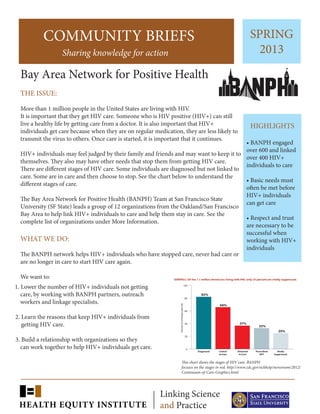
BANPH CB
- 1. Linking Science and Practice COMMUNITY BRIEFS Sharing knowledge for action Bay Area Network for Positive Health HIGHLIGHTS • BANPH engaged over 600 and linked over 400 HIV+ individuals to care • Basic needs must often be met before HIV+ individuals can get care • Respect and trust are necessary to be successful when working with HIV+ individuals SPRING 2013 THE ISSUE: More than 1 million people in the United States are living with HIV. It is important that they get HIV care. Someone who is HIV positive (HIV+) can still live a healthy life by getting care from a doctor. It is also important that HIV+ individuals get care because when they are on regular medication, they are less likely to transmit the virus to others. Once care is started, it is important that it continues. HIV+ individuals may feel judged by their family and friends and may want to keep it to themselves. They also may have other needs that stop them from getting HIV care. There are different stages of HIV care. Some individuals are diagnosed but not linked to care. Some are in care and then choose to stop. See the chart below to understand the different stages of care. The Bay Area Network for Positive Health (BANPH) Team at San Francisco State University (SF State) leads a group of 12 organizations from the Oakland/San Francisco Bay Area to help link HIV+ individuals to care and help them stay in care. See the complete list of organizations under More Information. WHAT WE DO: The BANPH network helps HIV+ individuals who have stopped care, never had care or are no longer in care to start HIV care again. We want to: This chart shows the stages of HIV care. BANPH focuses on the stages in red. http://www.cdc.gov/nchhstp/newsroom/2012/ Continuum-of-Care-Graphics.html 1. Lower the number of HIV+ individuals not getting care, by working with BANPH partners, outreach workers and linkage specialists. 2. Learn the reasons that keep HIV+ individuals from getting HIV care. 3. Build a relationship with organizations so they can work together to help HIV+ individuals get care.
- 2. HOW WE DO IT: The 12 Bay Area BANPH organizations work with the poorest and hardest to find individuals. These include individuals who have very little money, people getting ready to leave jail or prison, drug and alcohol users, transgender persons, immigrants and people of color. The organizations include public health departments, jails and prisons, community-based clinics and AIDS service organizations. HIV+ individuals are found through outreach workers and people who have lots of experience in helping individuals get care (also called ‘Linkage Specialists’). The BANPH network has helped over 400 HIV+ individuals get HIV care. Many of the organizations have hired HIV+ individuals who as peers are effective in helping link other HIV+ individuals to care. It also increases community support for HIV+ individuals. WHO WE HAVE REACHED: WHAT WE HAVE LEARNED: There are many reasons why people are not in HIV care. Some examples include not wanting their family or friends to know they have HIV or they are scared to get care. There are also other issues that may stop someone from getting care. Some of these issues are: • Lack of housing (38% of the people that BANPH worked with were homeless) • Not having enough food • Untreated drug or alcohol addiction • Untreated mental illnesses • Lack of transportation We learned that the best way to help an individual get to their first appointment is for outreach workers to pick them up and take them to the appointment. WHAT WE RECOMMEND: It is important to be patient and know that making the link to care will take time. We recommend that outreach workers be flexible and are available as soon as the individual is ready to meet. It is important to have a relationship with each HIV+ individual. Those working with HIV+ individuals need to be sensitive and understand there are reasons why they are not getting care. Respect and trust are necessary to be successful. Met 602 HIV+ Individuals and linked 406 to care 30% women 58% men 8% transwomen Most individuals have been living with HIV for about 10 YEARS 49% African American 20% Latino 11% White 20% mixed and other www.healthequityinstitute.org
- 3. Make sure you listen to the individual about where they want to get their care. There are many reasons someone may not want to get their care in the place you recommend. Some examples include not having a way to get there or not wanting to get care close to their home. We recommend you talk with the individual and ask them which place or location will help them be able to keep going for care on a regular basis. The individuals social network (family members and friends) are important relationships for outreach workers or linkage specialists to develop. Family and friends can help the outreach workers get ahold of the individuals and can help make sure the individual continues to get HIV care. MORE INFORMATION: This project was supported by AIDS United-Access to Care National Initiative BANPH Team: Cynthia A. Gómez, Project Director Nicholas Alvarado, Network Coordinator Danielle Gordon, Evaluation & Clinical Coordinator Dennis Browe, Project & Evaluation Assistant Debra Allen, Outreach Coordinator Rosario Noble, Linkage Specialist To learn more about the BANPH project and to read more Community Briefs, visit our website. www.healthequityinstitute.org BANPH Network Partners: -Alameda County Medical Center, Highland Hospital -Centerforce -Corizon/Santa Rita Jail -Forensic AIDS Project -HIV Education and Prevention Project of Alameda County/Casa Segura -Lifelong Medical Care -Mission Neighborhood Health Center -Oakland Office of AIDS Administration- Alameda -South-East Health Center -San Francisco Department of Public Health -WORLD (Women Organized to Respond to Life-Threatening Disease)